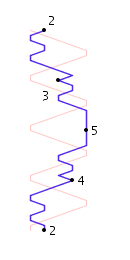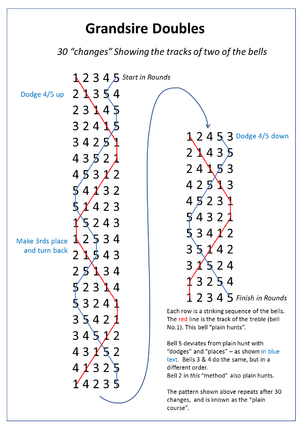Fabian Stedman facts for kids
Fabian Stedman (1640–1713) was an English author who played a huge role in the early history of campanology, which is the study of bells and bell ringing. He was especially important in a special type of bell ringing called method ringing. He helped publish two important books: Tintinnalogia (in 1668 with Richard Duckworth) and Campanalogia (in 1677, written only by him). These were the very first books ever published about bell ringing methods! People also see him as a pioneer in a part of mathematics called Group theory.
Contents
Fabian Stedman: Bell Ringing Pioneer
His Early Life and Bell Ringing
Fabian Stedman was born in Yarkhill, England, in 1640. He was the third son of Reverend Francis Stedman, who became a priest in Yarkhill. When Fabian was about 15, he moved to London. There, he started learning the printing trade. But it was in London that he became famous for his bell ringing skills.
While in London, Fabian joined a bell ringing group called the Scholars of Cheapside. They practiced at St Mary-le-Bow church, known for its famous Bow Bells. He was their treasurer in 1662. Later, he joined another important group, the Ancient Society of College Youths, in 1664. He became a leader in this society, serving as steward in 1667 and then as Master in 1682.
Not much is known about Fabian's later life. It seems he stopped focusing on bell ringing. He took a new job as an auditor for the Crown's HM Customs and Excise. Fabian Stedman passed away in 1713 and was buried in London.
The First Bell Ringing Books
Tintinnalogia: A First Look
Fabian Stedman helped publish the first book about change ringing. It was called Tintinnalogia. Richard Duckworth, a church leader, wrote most of it. This book came out in 1667. It really helped spread change ringing in the 1600s. It was so popular that a second edition was printed just one year later.
The book first explained "single changes." In these, only one pair of bells swapped places in each new row. Then, it talked about "cross changes." Here, more than one pair of bells changed positions at once. One example was "Doubles and Singles on four bells." This is now known as Plain Bob Minimus. The book also described methods for five bells, like Grandsire, which is still used today.
Campanalogia: Stedman's Own Book
After Tintinnalogia came out, change ringing grew quickly. Fabian Stedman saw the need for a new, updated book. So, he wrote Campanalogia all by himself in 1677. In this book, he called single change patterns "plain changes." He also introduced a simpler way to write down bell ringing patterns. This made it easier to understand the changes.
A big step forward in Campanalogia was the many new methods it shared. Stedman himself created 53 new methods for five, six, seven, and eight bells. One of his five-bell methods was "Stedman's Principle." This method is still very popular today. Publishing these methods encouraged more people to try and develop them. For example, in 1684, the College Youths rang 2,160 changes without stopping their bells!
What is Change Ringing?
How Bells Make Music
In English churches, bells are tuned carefully. But they are not usually played to make melodies or tunes. Instead, they are rung in "changes." Imagine a church with five bells. They might be numbered 1-2-3-4-5. Bell 1, called the treble, has the highest note. Bell 5, the tenor, has the lowest. When they ring in order (1-2-3-4-5), it's called "rounds." When their order changes in a planned way, they are "ringing the changes." This is why it's called change ringing.
A bell's swing takes a certain amount of time. Ringers cannot change this much. So, bells can only swap places with a bell right next to them in the ringing order. For example, starting from 12345, bell 3 can swap with bell 2 to make 13245. Or it can swap with bell 4 to make 12435.
Before Stedman's time, only one pair of bells would swap at a time. The goal was to start with "rounds," ring every possible order of the bells once, and then finish with "rounds" again. This was called an "extent." This "plain changes" method was slow. It could also be boring for ringers whose bells didn't move much.
Stedman's Smart Changes
Fabian Stedman's big achievement was creating "methods." These were also known as "cross-changes." His methods could create an "extent" much faster. They did this by changing more than one pair of bells at a time. For example, starting with 12345, you might go to 21354, then to 23145, and so on. This made ringing more interesting for everyone. It also allowed for more artistic patterns.
One of the earliest methods, "Doubles and Singles," is shown in a diagram with this article. Another common method today is "Grandsire Doubles."
As churches added more bells, Stedman's methods were used for larger numbers of bells. The number of possible changes grows very fast with more bells. For example, an "extent" on 10 bells would take about three months to ring! So, ringing 5,000 or more changes became known as a peal. In a peal, no change can be repeated, and bells still only swap with their neighbors. Today, hundreds of methods are practiced. All of them owe something to Stedman's early work. His ideas are also important in mathematics.
His Lasting Impact
Fabian Stedman was a very important person in the early days of change ringing. He is best remembered today for his ringing "principle." This is called "Stedman's Principle." It's special because all the bells follow the same pattern of changing. This principle is still rung as much today as it was in the 1600s. "Stedman Doubles to Cinques" (for 5 to 11 bells) is rung in many churches in Britain, Ireland, and other countries that do English style method ringing.
For example, "Grandsire Caters" (on 10 bells) was very popular for a long time. But more recently, "Stedman Caters" has become even more popular. This shows how important Stedman's ideas still are for bell ringers everywhere.
See also
- Albert J Pitman
- John Holt (composer)



